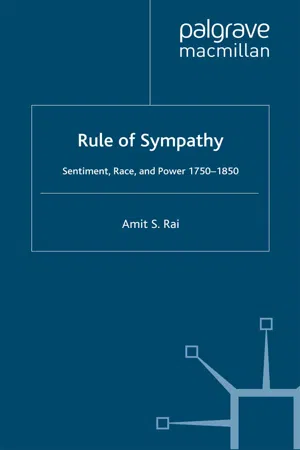
- English
- PDF
- Available on iOS & Android
About this book
The Rule of Sympathy is a social and historical critique of sympathy in British discourse in the late eighteenth and early nineteenth century. Although initially associated with feminized or effeminate forms of sentimental discourse (the romance, the novel, the gothic), sympathy came to function as a key technology of gender and race in new evangelical social movements, such as abolitionism and missionizing. Amit Rai argues that sympathy was a paradoxical mode of power. The differences of racial, gender and class inequalities that increasingly divided the object and agent of sympathy were precisely what must be bridged through identification. Yet without such differences, which were differences of power, sympathy itself would be impossible. This paradoxical mode of power transformed the ways in which people came to think of how best to manage, order, and govern individuals and populations in the late eighteenth century.
Frequently asked questions
- Essential is ideal for learners and professionals who enjoy exploring a wide range of subjects. Access the Essential Library with 800,000+ trusted titles and best-sellers across business, personal growth, and the humanities. Includes unlimited reading time and Standard Read Aloud voice.
- Complete: Perfect for advanced learners and researchers needing full, unrestricted access. Unlock 1.4M+ books across hundreds of subjects, including academic and specialized titles. The Complete Plan also includes advanced features like Premium Read Aloud and Research Assistant.
Please note we cannot support devices running on iOS 13 and Android 7 or earlier. Learn more about using the app.
Information
Table of contents
- Cover
- Rule of Sympathy
- Contents
- Acknowledgments
- Preface
- Chapter One Sympathetic Governmentality
- Chapter Two The Rules of Sympathy
- Chapter Three “Some Inscrutable Appeal”
- Chapter Four Theaters of Horror
- Conclusion: In the Name of Sympathy
- Notes
- Bibliography
- Index